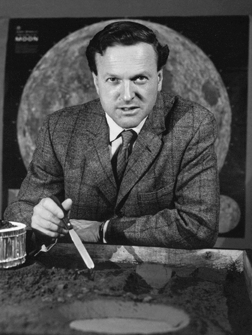PBS film examines career of CU renegade Tommy Gold
By George Lowery

The Cornell professor who helped NASA put men on the moon, recruited Carl Sagan to the Cornell faculty and advanced controversial theories on everything from the physiology of hearing to the consistency of the moon's surface to the origins of oil is the subject of a forthcoming documentary, "Renegade Genius: The Story of Tommy Gold," airing on PBS stations in May and June.
The film portrays Gold, who died in 2004, as a "brilliantly original thinker," far ahead of his time, who thought far outside the box. At a time when disciplinary boundaries were high, Gold leapt over them with ideas practical and visionary. Though not always right, Gold's ideas forced the conservative scientific community to consider new ways of thinking over many decades.
"He really thought that if you disagreed with him, you were either a crook or an idiot," says Freeman Dyson of the Institute for Advanced Study.
Yervant Terzian, Cornell's David C. Duncan Professor in the Physical Sciences and former chair of the astronomy department, also interviewed in the documentary, says Gold was "an exuberant thinker, he was a free spirit, and he was fearless."
Gold came to Cornell in 1959, retiring after nearly three decades on campus, during which time he helped rebuild the astronomy department, was a champion of the new Space Sciences Building and aided the establishment of the Arecibo Observatory in Puerto Rico.
At the outbreak of World War II, Gold, who was born in Vienna, was one of 70,000 Austrians and Germans in Britain sent to internment camps. Returning to Britain, he was hired to work on the British effort to build radar. Gold solved a major radar problem of distinguishing between the tiny strips of aluminum foil dropped by German fighter planes to elude detection and the planes themselves.
In 1946 Gold landed a fellowship at a zoological laboratory, where he theorized that the cochlea, the spiral cavity of the inner ear, works like a radio amplifier to boost the hearing signal. His theory was dismissed until, 40 years later, he was proven correct when physiologists found the microscopic structures Gold had predicted.

In the 1960s Gold worked closely with NASA, bringing research funds to Cornell and designing a stereo space camera to record the lunar surface. He stirred controversy by warning that there was likely to be dust on the surface -- possibly even deep enough to drown astronauts. The Apollo 11 mission showed that he was wrong about the depth of the dust -- it was only a few inches deep -- but the existence of any dust at all, Terzian comments in the film, proved that Gold was "at least 50 percent right."
In 1968 Gold turned to pulsars -- which had been observed by Cambridge graduate student Jocelyn Bell -- becoming the first to describe them as fast-rotating neutron stars that emit lighthouse-like pulses of electromagnetic radiation. The same year, Gold suggested the space shuttle be scrapped due to its risks to astronauts. NASA withdrew his research funds, but the Challenger disaster in 1986 confirmed his fears.
During the energy crisis of the early 1970s, Gold proposed that hydrocarbons were not formed from decayed plants or animals and that most oil and gas sources comes from "abiogenic" primordial chemicals deep in the Earth's mantle.
This led to deep drilling in Sweden to find commercial quantities of oil in 1986. Some oil was found five miles down, but the experiment was abandoned before the drill reached the desired depth due to repeated mechanical problems. Gold never admitted he was wrong about the source of oil. Instead, in 1992 he published a paper expanding his theory by positing the existence of a "deep hot" biosphere beneath the Earth's surface -- a theory that explained a number of findings of organisms that live independent of photosynthesis. This theory has won wide acceptance.
"I would say he was a genius," says Terzian at the close of the film. "How else would you define people that have such insights?"
The program will air locally on WCNY May 5 at 9 p.m. and on WSKG-HD June 11 at 8 p.m.
Get Cornell news delivered right to your inbox.
Subscribe